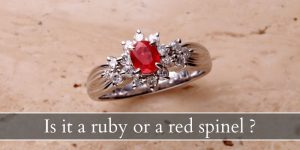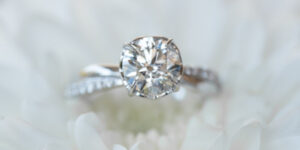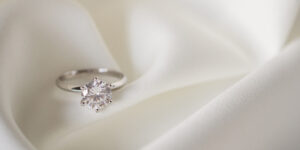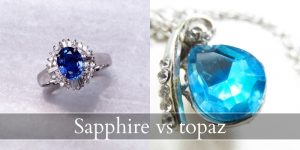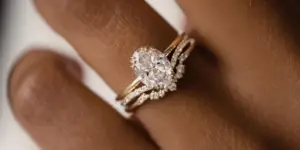When it comes to diamond simulants there are only two options, and those are moissanite and cubic zirconia. Both are beautiful in their own way and so much more affordable than a natural diamond. This means you have two options to look at when shopping for an affordable engagement ring, or if you’d like to have some a bigger rock for less cash.
So let’s talk about the key differences between moissanite and cubic zirconia. We’ll compare the two, and give you a third option to consider, if you’re unhappy with these two. So read on !
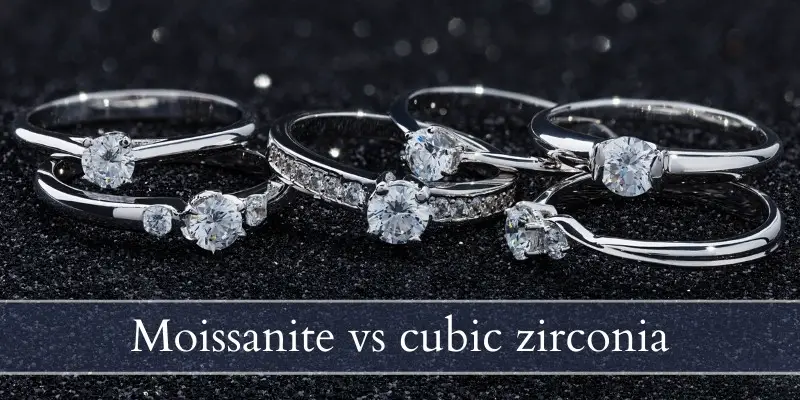
Moissanite vs cubic zirconia
Moissanite has superior durability, fire and brilliance, and comes with a higher price tag then cubic zirconia. While CZ is very affordable it scratches a little easier and is denser than moissanite, requiring you to get a larger carat than you would initially think.
Overall moissanite is the better diamond simulant, in terms of color, durability, density, and a more believable price.
What is moissanite ? Moissanite is actually silicone carbide and occurs very rarely in nature. Thus, pretty much all moissanite rings you will ever see actually feature lab-grown moissanite.
What is cubic zirconia ? Cubic zirconia is a lab-grown diamond simulant, and it is zirconium dioxide. This one was supposed to be a synthetic version of the natural mineral zircon, as that is very rare. Cubic zirconia became a very popular diamond simulant sometime in the ’80s.
Now let’s compare moissanite and cubic zirconia so you have a better idea of how they differ.
1. Moissanite is harder, more durable than cubic zirconia
While both moissanite and CZ are lab-grown, they still differ in composition, and this makes them differ in hardness. On the Mohs scale of hardness, a mineral’s resistance to scratching and chipping is measured on a scale of 1 to 10. This is not a regular scale, since the difference between 8 and 9 is smaller than the difference between 9 and 10.
Read also: Can Any Ring Be An Engagement Ring ?
A diamond scores a 10 on this scale, and it’s the hardest gemstone. Moissanite scores 9.25-9.5 which is very tough, tougher than sapphires and rubies. And cubic zirconia scores 8.5, which is still tough but softer than moissanite.
Why does this matter ? The tougher the gem. the less scratches it will accumulate as you wear it every day. The less chances of it chipping and having to be replaced. So in this case moissanite will hold up much better in time that cubic zirconia.
2. Cubic zirconia is more affordable than moissanite
There is a big price difference between cubic zirconia and moissanite. Moissanite is lab grown but requires specific materials in its composition, and they are not as readily available as CZ. So, a 1 ct moissanite can sell for $400-600 depending on the seller and cut. Meanwhile cubic zirconia sells for far, far less, around $15 per carat.
So if you’re looking for a larger rock to wear, cubic zirconia would make for a very affordable choice. Of course, an overly-large CZ would be just too much and turn the ring from impressive to tacky in a heartbeat.
3. Moissanite has more fire and brilliance than cubic zirconia
Color and sparkle is why we all love diamonds. So do moissanite and CZ live up to the expectation ? This is largely dictated by their refractive indexes.
Diamonds have a refractive index of 2.42, and the round brilliant cut was developed to use that index to its maximum potential. The same cut on a cubic zirconia will offer slightly less sparkle, as it has a refractive index of 2.15-2.18 and the light behaves a bit differently within the gem. Still sparkly, but not as impressive as a diamond when put side by side.
Moissanite has a refractive index of 2.65 and it has more sparkle than a diamond even, but it tends to have more colorful flashes than an even mix of white and rainbow.
Still, comparing moissanite to CZ makes shows that moissanite has superior fire and brilliance than CZ. Both are great and will sparkle like mad in a ring. But compared, moissanite wins.
4. Cubic zirconia is denser than moissanite, appears smaller
Do not compare carat weight when it comes to moissanite and cubic zirconia. You will always need a CZ that is nearly double the carat of moissanite to get a similar size. Which is fine because this is a cheap gem and going from 1 to 2 carats is not a budget problem.
Diamonds and gemstones are measures in carat weight, and this can be a bit troublesome when comparing different materials. You see, when you think of a 1 ct diamond, you expect a 6×6 mm diamond. But a 1 ct cubic zirconia will look much smaller, at about 3×3 mm. Why ?
Density is key, because carats actually measure the weight of a diamond, not its size. So in truth a 1 ct diamond is 0.200 gr worth of diamond. A material that has a higher density would reach the 0.200 gr goal before it reached the 6×6 mm size.
Moissanites have a density of 3.2 gr/cm3, which is very, very similar to a diamond’s density 3.5 gr/cm3. So a 1 ct moissanite will look nearly the same as a 1 ct diamond, in terms of size.
Cubic zirconia is much more dense (5.65 gr/cm3) which means that 0.200 gr of cubic zirconia will look like a 0.5 ct diamond in size, despite weighting the same as a 1 ct diamond.
Consider lab-grown diamonds as an alternative
If you’re not convinced that moissanite or cubic zirconia are good choices for you, why not opt for lab-grown diamonds ? These have the same structure as a natural diamond, and often turn up with very high clarity and very good color. Of course, they are not a natural stone so they lose in the authenticity department. Then again, so are moissanite and CZ, so we’re not straying too far from the original idea.
The price range for lab-grown diamonds is around the $1000 mark per carat. The price is generally lower than natural diamonds. The upside is that you can easily find a created diamond in the color, size, and clarity you want. And, as lab-grown diamonds, they are 100% conflict free.

I’m the main author for jewelrymaterialguide.com. I started this site after we did tons of research before our wedding and noticed that there is information about rings, jewelry, and so on that is really hard to find on the internet.


